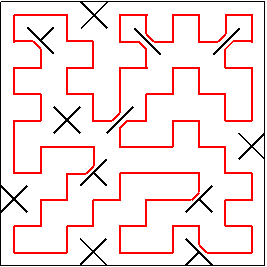LABIRINT WITHOUT WALLS
These labyrinths are very different from traditional mazes. Instead of trying to escape a maze filled witth wallw, you’re traveling freely in an open spase filled witth three different types of obstacles. Here are the rules:

Moving horizontally and vertically, but not diagonally, you must pass through each square once (except for the two exceptions below). Your path may not cross itself, and must form a complete loop, ending where you began.
You connot enter squares marked with an X.
You must enter squares with a diagonal line twice, but you may not cross the line.
You may move through squares with a diagonal T-shape only once, and only through the “free” half.Again, you may not cross the lines.
Let us try to solve the sample puzzle.
First of all, taking the rules into accountt, mark the parts of the route that already have conditions. The grid now looks like this:
So how do you the path through the rest of the squares?
You connot enter squares marked with an X.
You must enter squares with a diagonal line twice, but you may not cross the line.
You may move through squares with a diagonal T-shape only once, and only through the “free” half.Again, you may not cross the lines.
Let us try to solve the sample puzzle.
First of all, taking the rules into accountt, mark the parts of the route that already have conditions. The grid now looks like this:
So how do you the path through the rest of the squares?

First, you want to find squares in which there are only two possible exits; that is, of the four ways to move from that square to anadjacent square, two of them are blocked by the edge of the grid, or the side of an obstacle, or another part of the path. For instance, every corner square of the grid only has two exits, and may be marked. The grid now looks like this:

By continuing to search for squares with only two exits, and bearing in mind that the path never crosses itself but forms a closed loop, we find the following solution:

Now try to solve these puzzles: